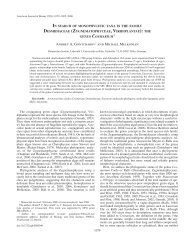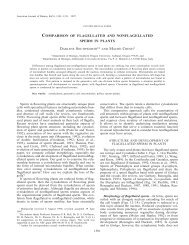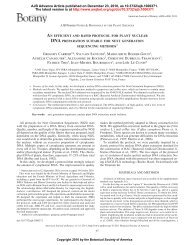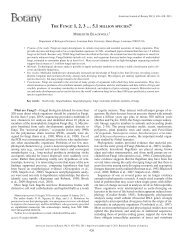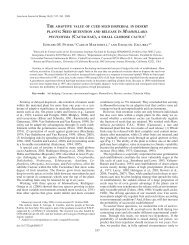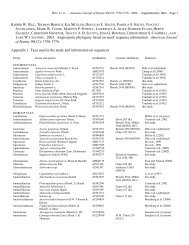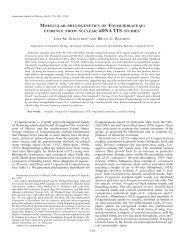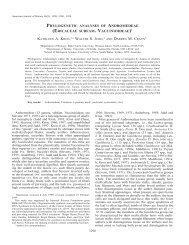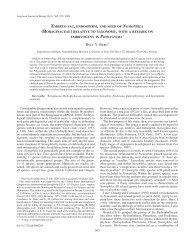Jennifer H. Richards 2,4 , Marlene Dow 2 - American Journal of Botany
Jennifer H. Richards 2,4 , Marlene Dow 2 - American Journal of Botany
Jennifer H. Richards 2,4 , Marlene Dow 2 - American Journal of Botany
You also want an ePaper? Increase the reach of your titles
YUMPU automatically turns print PDFs into web optimized ePapers that Google loves.
During sexual reproduction <strong>of</strong> species in the aquatic genus<br />
Nymphoides (Menyanthaceae), the fl owers appear to arise directly<br />
from the petiole <strong>of</strong> a fl oating leaf. The elongated structure<br />
beneath both the infl orescence and leaf, however, is a stem<br />
( Goebel, 1891 ; Raynal, 1974 ; Godfrey and Wooten, 1981 ;<br />
Wood, 1983 ; Sivarajan and Joseph, 1993 ). The infl orescence<br />
and fl oating leaf form a complex that can produce vegetative<br />
propagules and/or additional infl orescences and leaves. The<br />
morphology and growth <strong>of</strong> these additional apices differs<br />
among Nymphoides species with respect to internodal elongation,<br />
branch number, whether fl owers and/or leaves are formed,<br />
and whether adventitious roots are produced ( Goebel, 1891 ;<br />
Aston, 1973 ; Raynal, 1974 ; Van Der Velde et al., 1979 ;<br />
Godfrey and Wooten, 1981 ; Van Der Velde and Van Der Heijden,<br />
1981 ; Wood, 1983 ; Sivarajan and Joseph, 1993 ). Although the<br />
infl orescence/fl oating leaf complex <strong>of</strong> some species <strong>of</strong> Nymphoides<br />
has been described, how this complex relates to whole<br />
plant architecture has not been studied. Most authors describe<br />
growth <strong>of</strong> Nymphoides as sympodial when referring to the infl<br />
orescence, but branching in other parts <strong>of</strong> the shoot system,<br />
and even branching in the infl orescence <strong>of</strong> some species, is<br />
described as axillary or monopodial, although no supporting<br />
1 Manuscript received 5 July 2010; revision accepted 14 September 2010.<br />
The authors thank P. Gr<strong>of</strong>f, F. Gualchi, D. Van Dillewijn, G. Bobadilla,<br />
A. Castellanos and W. Zagarra for help measuring and maintaining plants<br />
in the mesocosms and processing laboratory material. This project was<br />
funded by Cooperative Agreement CA H5297-05-0013 between Everglades<br />
National Park and Florida International University.<br />
4 Author for correspondence (e-mail: richards@fi u.edu)<br />
doi:10.3732/ajb.1000242<br />
1761<br />
<strong>American</strong> <strong>Journal</strong> <strong>of</strong> <strong>Botany</strong> 97(11): 1761–1771. 2010.<br />
M ODELING NYMPHOIDES ARCHITECTURE: A MORPHOLOGICAL<br />
ANALYSIS OF NYMPHOIDES AQUATICA (MENYANTHACEAE)<br />
1<br />
<strong>Jennifer</strong> H. <strong>Richards</strong> 2,4 , <strong>Marlene</strong> <strong>Dow</strong> 2 , and Tiffany Troxler 2,3<br />
2 Department <strong>of</strong> Biological Sciences, Florida International University, Miami, Florida 33199 USA; and<br />
3 Southeast Environmental Research Center, Florida International University, Miami, Florida 33199 USA<br />
Premise <strong>of</strong> the study : Species in the aquatic genus Nymphoides have infl orescences that appear to arise from the petioles <strong>of</strong><br />
fl oating leaves. The infl orescence-fl oating leaf complex can produce vegetative propagules and/or additional infl orescences and<br />
leaves. We analyzed the morphology <strong>of</strong> N. aquatica to determine how this complex relates to whole plant architecture and<br />
whether whole plant growth is sympodial or monopodial.<br />
Methods : We used dissections, measurements, and microscopic observations <strong>of</strong> fi eld-collected plants and plants cultivated for<br />
2 years in outdoor tanks in south Florida, USA.<br />
Key results : Nymphoides aquatica had a submerged plagiotropic rhizome that produced fl oating leaves in an alternate/spiral<br />
phyllotaxy. Rhizomes were composed <strong>of</strong> successive sympodial units that varied in the number <strong>of</strong> leaves produced before the<br />
apex terminated. The basic sympodial unit had a prophyll that subtended a renewal-shoot bud, a short-petioled leaf (SPL) with<br />
fl oating lamina, and an infl orescence; the SPL axillary bud expanded as a vegetative propagule. Plants produced either successive<br />
basic sympodial units or expanded sympodia that intercalated long-petioled leaves between the prophyll and the SPL.<br />
Conclusions : Nymphoides aquatica grows sympodially, forming a rhizome composed <strong>of</strong> successive basic sympodia and expanded<br />
sympodial units. Variations on these types <strong>of</strong> sympodial growth help explain the branching patterns and leaf morphologies<br />
described for other Nymphoides species. Monitoring how these two sympodial phases are affected by water depth provides<br />
an ecologically meaningful way to assess N. aquatica ’ s responses to altered hydrology.<br />
Key words: aquatic plant; clonal propagation; Everglades; heterophylly; leaf dimorphism; prophyll; slough; sympodial; vegetative<br />
reproduction.<br />
evidence for these descriptions has been given ( Raynal, 1974 ;<br />
Van Der Velde et al., 1979 ; Brock et al., 1983 ; Kasinathan and<br />
Muthu, 1993 ; Sivarajan and Joseph, 1993 ).<br />
In monopodial growth the stem is formed by a single apical<br />
meristem, while in sympodial growth the stem is produced by a<br />
succession <strong>of</strong> apical meristems ( Fig. 1) ( Bell, 2008 ). A sympodial<br />
shoot meristem grows for some period then becomes determinate<br />
or subordinate, and growth <strong>of</strong> the main axis is taken<br />
over by an axillary bud meristem, designated the renewal-shoot<br />
meristem. The arrangement <strong>of</strong> leaves, stems, and meristems<br />
provides evidence for whether a stem has monopodial or sympodial<br />
growth. A monopodial axis has leaves that are lateral to<br />
the stem, and each leaf subtends an axillary bud. The fi rst leaf<br />
on this axillary bud, the prophyll, is <strong>of</strong>ten a bract and occurs in<br />
the addorsed position between the bud and the main stem in<br />
monocotyledons and some basal angiosperms ( Fig. 1A ); alternatively,<br />
many eudicotyledons produce two opposite prophylls,<br />
which then occur laterally on the bud ( Bell 2008 ; Doyle and<br />
Endress 2000 ). In sympodial growth, these relationships <strong>of</strong><br />
stem, leaf, axillary bud, and prophyll are altered ( Fig. 1B ). The<br />
original axis is overtopped by growth <strong>of</strong> the new axis; if the<br />
original axis keeps growing, it can appear to be lateral, but it<br />
will not be subtended by a leaf ( Fig. 1B ), while the leaf that<br />
subtended the axillary bud that has taken over growth <strong>of</strong> the<br />
main axis may lack an axillary bud, since its bud has grown out<br />
as the renewal shoot ( Fig. 1B ). Finally, the prophyll <strong>of</strong> the axillary<br />
bud will be on the new main axis, rather than occurring<br />
laterally (P, Fig. 1B ). Thus, analysis <strong>of</strong> the positional relations<br />
<strong>of</strong> leaves, axillary buds, and branches can discriminate between<br />
sympodial and monopodial growth.<br />
Species <strong>of</strong> Nymphoides are found primarily in the Old World<br />
tropics (especially Africa, Madagascar, and Australia ( Raynal,<br />
<strong>American</strong> <strong>Journal</strong> <strong>of</strong> <strong>Botany</strong> 97(11): 1761–1771, 2010; http://www.amjbot.org/ © 2010 Botanical Society <strong>of</strong> America
1762 <strong>American</strong> <strong>Journal</strong> <strong>of</strong> <strong>Botany</strong> [Vol. 97<br />
Fig. 1. Diagram <strong>of</strong> differences in monopodial and sympodial shoot growth. (A) In monopodial growth a single apical meristem, A1, forms the main<br />
shoot axis, bearing lateral leaves that subtend axillary buds/ branches (e.g., A2). (B) In sympodial growth, the main shoot axis is formed by a succession <strong>of</strong><br />
apical meristems. In the diagram the original apical meristem A1 is replaced by an axillary bud meristem, A2, displacing the A2 prophyll onto the main axis.<br />
1974 ), but also India ( Sivarajan and Joseph, 1993 ) and east Asia<br />
( Li, Hsieh, and Lin 2002 )); the genus also includes New World<br />
species and one European and Asian species ( N. peltata )<br />
( Ornduff, 1969 ; Correll and Correll, 1982 ; Wood, 1983 ;<br />
Mabberley, 1989 ; Smith et al., 2004 ). Both submerged and<br />
fl oating axillary branch stolons have been described from some<br />
<strong>of</strong> the species ( Van Der Velde et al., 1979 ; Sivarajan and<br />
Joseph, 1993 ), but no published research has examined the origin<br />
<strong>of</strong> these branches. Various types <strong>of</strong> leaf dimorphisms, including<br />
submerged vs. fl oating leaves, have also been reported.<br />
Nymphoides aquatica (J.F.Gmel.) Kuntze, big fl oating heart,<br />
is a common North <strong>American</strong> species native to the southeastern<br />
United States, where it ranges north to Delaware and west to<br />
Texas ( USDA, NRCS, 2010 ; Godfrey and Wooten, 1981 ;<br />
Wood, 1983 ; Wunderlin and Hansen 2003 ). The species is dioecious,<br />
and infl orescences are found at the water ’ s surface associated<br />
with a cordate, laminate-petiolate fl oating leaf ( Wood,<br />
1983 ). Nymphoides aquatica is capable <strong>of</strong> abundant vegetative<br />
reproduction from plantlets produced in association with the<br />
infl orescences ( Dress, 1954 ; Wood, 1983 ).<br />
Nymphoides aquatica is a common member <strong>of</strong> the deeper<br />
water slough habitats <strong>of</strong> the southern Florida Everglades<br />
( Gunderson, 1994 ). In the U. S. Water Resources Development<br />
Act <strong>of</strong> 2000, these habitats were included in the $9.5 billion,<br />
30-yr, comprehensive Everglades restoration plan. Research on<br />
the hydrologic optimum and tolerances <strong>of</strong> N. aquatica requires<br />
understanding the plant ’ s morphology to measure its responses to<br />
hydrologic change. There are no detailed morphological studies<br />
<strong>of</strong> either N. aquatica or N. cordata , the other native North<br />
<strong>American</strong> species <strong>of</strong> Nymphoides . Although the general struc-<br />
ture <strong>of</strong> the fl oating leaves, infl orescences, and fl owers has been<br />
described ( Wood, 1983 ; Ornduff, 1966 ), how these fl oating<br />
parts <strong>of</strong> the plant relate to the submerged rhizome, roots, and<br />
branches has not been studied, and whether the plants have the<br />
submerged leaves and stolons described for other species <strong>of</strong><br />
Nymphoides is not known. The purpose <strong>of</strong> the work presented<br />
here was to analyze the morphology <strong>of</strong> N. aquatica to determine<br />
whether whole plant growth is sympodial or monopodial.<br />
A second goal was to develop a general model for the architecture<br />
<strong>of</strong> N. aquatica to guide our research on this species ’ responses<br />
to hydrologic change and to help analyze the architecture<br />
<strong>of</strong> other Nymphoides species.<br />
MATERIALS AND METHODS<br />
Field collections — Plants for this study were collected from southern<br />
Florida in the South Florida Water Management District ’ s Water Conservation<br />
Area 3, which is directly north <strong>of</strong> Everglades National Park. Our primary<br />
collecting site was 25 ° 47 ′ 8.881 ″ N, 80 ° 41 ′ 16.431 ″ W; we also collected from<br />
sites within a 5 km radius <strong>of</strong> this primary site. Initial plant collections were<br />
made July and August 2005, with supplemental collections made September<br />
and October 2005; July, September, and November 2006; May 2007; and<br />
June 2008. Specimens were transported to Florida International University,<br />
where some plants were planted in 19 cm diameter × 12.5 cm high pots in peat<br />
humus organic growing medium (Greenleaf Products, Haines City, Florida, USA)<br />
and grown outside in mesocosms. Other plants were dissected, observed, and<br />
digitally photographed with a stereomicroscope. Some fi eld-collected dissected<br />
material was fi xed in 1 : 3 acetic acid : ethanol, embedded in paraplast<br />
( Ruzin, 1999 ), sectioned at 5 µ m, stained in safranin-haematoxylin-fast green,<br />
examined with a compound light microscope, and photographed with a digital<br />
camera.
November 2010] <strong>Richards</strong> et al. — NYMPHOIDES morphology and architecture<br />
Our mesocosm research showed that plants produced two types <strong>of</strong> fl oating<br />
leaves, ones with long petioles and ones with short petioles. Data on the number<br />
<strong>of</strong> long-petioled (LP) leaves and short-petioled (SP) leaves found on plants in<br />
the fi eld were collected in the wet season, 13 September 2006, and in the dry<br />
season, 11 May 2007. Three sites were sampled each time. The wet season<br />
sites were at our primary site, as well as 25 ° 47 ′ 21.159 ″ N, 80 ° 41 ′ 11.588 ″ W<br />
and 25 ° 47 ′ 43.160 ″ N, 80 ° 41 ′ 23.775 ″ W. The dry season sites were at our<br />
primary site and at 25 ° 47 ′ 13.489 ″ N, 80 ° 41 ′ 12.613 ″ W and 25 ° 47 ′ 28.469 ″ N,<br />
80 ° 41 ′ 9.917 ″ W. At each site, the numbers <strong>of</strong> LP and SP leaves on 20 plants<br />
were counted. Data on rhizome diameter and internode length, as well as number<br />
<strong>of</strong> bladeless petioles that remained on the plant after the lamina senesced,<br />
and mature leaves and leaf types, were collected from plants harvested 20 December<br />
2007 from the primary site (11 plants) and two additional sites in the<br />
area (25 ° 47 ′ 26.702 ″ N, 80 ° 41 ′ 19.437 ″ W and 25 ° 47 ′ 58.284 ″ N, 80 ° 41 ′ 11.993 ″ W,<br />
10 plants per site).<br />
Experimental mesocosms — The potted fi eld-collected N. aquatica plants<br />
were placed in 2.2 m diameter × 1 m deep round polypropylene tanks (mesocosms)<br />
that had shelves suspended at 30 and 60 cm depths; an additional shelf<br />
sat on the bottom <strong>of</strong> the mesocosm at 90 cm depth, allowing us to elevate these<br />
plants for observations and measurements. Data reported here were collected as<br />
part <strong>of</strong> a 2-yr experiment on the effects <strong>of</strong> water depth and hydroperiod on three<br />
common southern Florida slough species, so in addition to N. aquatica , each<br />
mesocosm also had potted specimens <strong>of</strong> Nymphaea odorata and Eleocharis<br />
elongata . We had nine experimental mesocosms in which we measured plants<br />
and made observations on a monthly basis; these mesocosms had three N.<br />
aquatica plants at each depth. We put plants into the experimental mesocosms<br />
18 and 19 November 2005. Quantitative morphological and phenological data<br />
reported here were taken from January 2006 through November 2007, when<br />
water levels were held constant in each tank. In February 2007 water levels<br />
were lowered 25 cm in six <strong>of</strong> the nine experimental tanks as part <strong>of</strong> a hydroperiod<br />
experiment; we report some observations from this experiment. Every<br />
month we collected data on the 81 plants; because <strong>of</strong> mortality and a midstudy<br />
harvest <strong>of</strong> 27 plants, the entire mesocosm study includes data from 139 N.<br />
aquatica plants.<br />
During monthly measurements, we marked all fl oating leaves with an indelible<br />
ink pen, using a different letter each month so that we could distinguish<br />
new leaves from older leaves. We also tagged the most recently matured leaf<br />
with a cable tie. Data taken each month included whether plants were fl owering<br />
or producing vegetative propagules and the presence and number <strong>of</strong> mature but<br />
submerged leaves. On the most recently matured leaf, we noted whether an infl<br />
orescence was associated with the leaf and took quantitative measurements,<br />
which will be reported in a separate paper. From June 2006 to November 2007,<br />
we made phenological observations on the 27 Nymphoides plants growing at<br />
30 cm water depth in the experimental mesocosms at 2 – 3-d intervals. Observations<br />
on these plants were number <strong>of</strong> new leaves, leaf type, and presence <strong>of</strong><br />
fl owers, fruit, and/or vegetative propagules.<br />
Data were analyzed using SAS 9.1 statistical s<strong>of</strong>tware (SAS Institute, Cary,<br />
North Carolina, USA). Means, medians, and standard deviations were determined<br />
for descriptive data. A contingency table analysis was used to test for<br />
differences between seasons in the proportion <strong>of</strong> SP and LP leaves on plants in<br />
the fi eld.<br />
RESULTS<br />
Mature morphology —<br />
Plants <strong>of</strong> Nymphoides aquatica had a<br />
single submerged plagiotropic rhizome that produced cordate,<br />
fl oating leaves ( Fig. 2 ) in an alternate/spiral phyllotaxy. Leaves<br />
were laminate-petiolate and had a sheathing leaf base. Successive<br />
internodes on the rhizome were short, being less than 2 mm<br />
long for material collected in the fi eld (median = 1.0 mm, range =<br />
1.0 – 2.0 mm, N = 31). Shoot-borne roots arose on the submerged<br />
rhizome ( Figs. 2, 3 ). These large roots produced fi ner<br />
lateral roots through additional orders <strong>of</strong> root branching. When<br />
rhizomes were exposed to the air, short thick roots were produced<br />
( Fig. 4 ).<br />
In the absence <strong>of</strong> injury or severe environmental disturbance,<br />
plants rarely produced vegetative branches (i.e., branches not<br />
associated with infl orescence production) from the submerged<br />
1763<br />
rhizome. None <strong>of</strong> our fi eld-collected material had vegetatively<br />
branched rhizomes, and in observations over 2 years in our experimental<br />
mesocosms, only two undisturbed rhizomes produced<br />
vegetative rhizome branches. Exposure <strong>of</strong> previously<br />
submerged rhizomes to air, however, caused dormant buds on<br />
the rhizomes to begin to expand on eight <strong>of</strong> 18 plants (44%;<br />
Fig. 4 ), while no vegetative rhizome branching occurred on 36<br />
plants in the same mesocosms whose rhizomes were not exposed.<br />
Plants produced one axillary bud per node. The axillary<br />
buds were unusual in having a single adaxial or addorsed prophyll<br />
( Figs. 5, 6 ), instead <strong>of</strong> the two lateral prophylls typical <strong>of</strong><br />
eudicotyledons ( Bell. 2008 ).<br />
Sympodial unit structure — Nymphoides aquatica rhizomes<br />
were composed <strong>of</strong> successive sympodial units. These units varied<br />
in the number <strong>of</strong> photosynthetic leaves produced before the<br />
apex produced fl oral bracts and fl owers. The basic sympodial<br />
unit consisted <strong>of</strong> a prophyll, a second short-petioled, photosynthetic,<br />
fl oating leaf (SPL), and an infl orescence that produced<br />
bracts and fl owers ( Figs. 2, 12, 18, 19 ). The prophyll was a thin,<br />
ensheathing bract that usually had a small rounded tip or vorl<br />
ä uferspitze (T, Fig. 8 ). The prophyl1 tip, however, occasionally<br />
developed as a more spatulate or laminate/petiolate structure<br />
with an oval photosynthetic lamina ( Fig. 9 ); this form occurred<br />
more frequently on plants whose rhizomes became emergent<br />
but was also observed occasionally on submerged plants in<br />
shallow water. The prophyll had a short ( < 2 mm) internode below<br />
it (^ in Figs. 23, 25 marks the prophyll scar with internode<br />
below) and subtended an axillary bud that functioned as a<br />
renewal shoot for the rhizome axis. The renewal-shoot bud did<br />
not go dormant but grew out continuously (sylleptically) to produce<br />
the next sympodial unit.<br />
The SPL had a cordate lamina that fl oated at the water surface<br />
( Figs. 12, 19 ). This leaf was tethered to the rhizome by a<br />
long internode (In, Figs. 2, 12, 19 ) that separated the SPL from<br />
the prophyll and elevated the sympodial unit shoot apex, bringing<br />
it close to the water surface. The sheathing base <strong>of</strong> the SPL<br />
was modifi ed, forming two protective fl aps that enclosed the<br />
developing infl orescence and remained at the base <strong>of</strong> the expanded<br />
infl orescence (Lb, Figs. 14, 15 ). After the sympodial<br />
unit ’ s shoot apical meristem formed the SPL, it began to produce<br />
bracts and fl owers, so all subsequent leaves were small,<br />
thin bracts that were enclosed by the SPL sheath ( Fig. 16 ). The<br />
third leaf, a small bract, was ca. 180 ° from the SPL, and additional<br />
bracts and fl owers were produced acropetally to these<br />
leaves on the condensed shoot axis positioned between the SPL<br />
and third leaf ( Figs. 14 – 16 ).<br />
The SPL subtended an axillary bud. This bud was found inside<br />
the modifi ed sheath <strong>of</strong> the SPL, which enclosed the infl orescence<br />
and axillary bud. The bud was located between the<br />
infl orescence and SPL petiole ( Figs. 15, 16 ). The prophyll <strong>of</strong><br />
this bud was inserted on the side <strong>of</strong> the bud adjacent to the infl<br />
orescence, with the opening <strong>of</strong> the prophyll sheath facing the<br />
SPL lamina and petiole ( Figs. 15 – 18 ); thus, it was addorsed to<br />
the sympodial unit stem and apex (i.e., the infl orescence) and<br />
faced the subtending SPL leaf. The infl orescence expanded<br />
fl owers continuously over a number <strong>of</strong> days. In our study, infl orescences<br />
on plants in shallow water took from 1 – 5 weeks to<br />
complete fl owering. Infl orescence production terminated<br />
growth <strong>of</strong> the sympodial unit that produced it.<br />
If the SPL axillary bud expanded, it produced a vegetative<br />
reproductive unit (VRU) that could disperse and establish a<br />
new plant. The VRU began growing while still attached to the
1764 <strong>American</strong> <strong>Journal</strong> <strong>of</strong> <strong>Botany</strong> [Vol. 97<br />
Figs. 2 – 11. General morphology <strong>of</strong> Nymphoides aquatica . 2 . Whole plant with horizontal rhizome bearing adventitious roots; fl oating, photosynthetic,<br />
long-petioled leaves (LPLs) on short internodes; and fl oating, photosynthetic, short-petioled leaves (SPLs) on long internodes. The SPLs have tuberous<br />
adventitious roots at their bases. Bar = 8 cm. 3. Horizontal rhizome with leaf scars <strong>of</strong> LPLs; the shoot tip is to the right. The scars <strong>of</strong> the sheathing leaf bases<br />
are broad in the middle and taper laterally. Adventitious roots emerge from the internodes. Bar = 5 mm. 4. Horizontal rhizome after the water was lowered,<br />
and the rhizome was exposed to air; axillary buds (*) <strong>of</strong> LPLs grew out, and short, thick, unbranched adventitious roots emerged from the rhizome. Bar =<br />
5 mm. 5. Frontal view <strong>of</strong> addorsed prophyll on small axillary bud. Bar = 100 µ m. 6. Frontal view <strong>of</strong> addorsed prophyll encasing the axillary bud <strong>of</strong> a LPL.<br />
Bar = 300 µ m. 7. Shoot tip <strong>of</strong> plant that transformed from producing LPLs to forming successive basic sympodia. Prophylls <strong>of</strong> successive sympodial units<br />
are numbered from older (P6) to younger (P8), although not all sympodial units are labeled. The long internode <strong>of</strong> the SPL on a basic sympodial unit has<br />
the same number as the prophyll for that sympodial unit (i.e., P6 and In6 are part <strong>of</strong> the same basic sympodial unit). Bar = 5 mm. 8. Prophyll <strong>of</strong> a basic<br />
sympodial unit; the prophyll has a sheathing lower leaf zone and small, club-shaped upper leaf zone (T). Bar = 1 cm. 9. Plant in which the upper leaf zone<br />
<strong>of</strong> two prophylls had expanded into ovate laminae borne on slender petioles (T). Bar = 2 cm. 10. Close-up <strong>of</strong> shoot tip in Fig. 7 with prophyll <strong>of</strong> basic<br />
sympodial unit 8 (P8) pulled back to show renewal-shoot bud that forms basic sympodial unit 9 with P9 and In9. Bar = 2 mm. 11. Young basic sympodial<br />
unit with young prophyll and elongating internode supporting an immature SPL and developing infl orescence. Bar = 2 mm. Abbreviations: B, lower leaf<br />
zone (leaf base); In, infl orescence internode; LPL, long-petioled leaf; LPLsc, long-petioled leaf scar; P, prophyll (number indicates order <strong>of</strong> initiation); Rh,<br />
rhizome; Rt, root; SPL, short-petioled leaf; T, upper leaf zone (lamina-petiole).<br />
parent plant ( Figs. 18, 19 ). This axillary bud produced the single<br />
addorsed prophyll ( Figs. 15, 17, 18 ), then either small laminate-petiolate<br />
leaves or, more rarely, infl orescence sympodial<br />
units ( Figs. 18 – 20 ). Growth <strong>of</strong> the SPL axillary bud was sometimes<br />
associated with the production <strong>of</strong> short, tuberous shootborne<br />
roots that emerged from the leaf base/nodal area <strong>of</strong> the
November 2010] <strong>Richards</strong> et al. — NYMPHOIDES morphology and architecture<br />
Figs. 12 – 17. Basic sympodial unit <strong>of</strong> Nymphoides aquatica . 12. Short-petioled leaf (SPL) and infl orescence with old fl owers on their long pedicels<br />
and unopened fl ower buds; the long internode has been cut <strong>of</strong>f below the infl orescence. The SP connects the SPL lamina to the internode. Bar = 2 cm. 13.<br />
Rhizome shoot tip showing a transition from long-petioled leaf (LPL) production on an expanded sympodial unit to production <strong>of</strong> successive basic sympodial<br />
units, each with a prophyll and the base <strong>of</strong> the long internode. Petioles <strong>of</strong> LPLs are numbered from older to younger (L1 – L4); In1 is the long internode<br />
<strong>of</strong> the infl orescence that terminates the expanded sympodial unit that produced L1 – L4. The bud axillary to L4 initiated a basic sympodial unit that produced<br />
a prophyll (P2) and an infl orescence at the tip <strong>of</strong> In2; the bud axillary to P2 grew out to produce P3 and In3 <strong>of</strong> the next basic sympodial unit. Bar = 1 cm.<br />
14. Young infl orescence with fl ower buds expanding from the SPL leaf base and the third leaf (L3), which is a bract at app. 180 ° from the SPL; SPL axillary<br />
bud not visible. Bar = 2 mm. 15. Older infl orescence with pedicels <strong>of</strong> mature fl owers and expanding fl ower buds emerging from the sheathing leaf base <strong>of</strong><br />
the SPL; the axillary bud <strong>of</strong> the SPL is expanding. Bar = 2 mm. 16. A young infl orescence with the sheathing base <strong>of</strong> the SPL removed to show the young<br />
axillary bud <strong>of</strong> the SPL, the L3, which develops at ca. 180 ° to the SPL and matures as a bract, and one other infl orescence bract. Bar = 500 µ m. 17. Longitudinal<br />
section <strong>of</strong> base <strong>of</strong> immature SPL showing the petiole <strong>of</strong> the SPL, its axillary bud with apical meristem and addorsed prophyll, and a fl oral meristem<br />
produced on the terminal infl orescence. Bar = 30 µ m. Abbreviations: F, fl ower; Fb, fl ower bud; L, leaf; Lb, leaf base; FM, fl oral meristem; Pd, fl ower pedicel;<br />
SP, short-petiole; SPL, short-petioled leaf; SPL ab, short-petioled leaf axillary bud; other abbreviations as in Figs. 2 – 11 .<br />
SPL and infl orescence ( Figs. 18 – 20 ). These roots grew to between<br />
1 and 3 cm long and then stopped elongating. After fl owering<br />
ceased, the VRU and SPL separated from the long<br />
internode and fl oated away ( Fig. 20 ).<br />
Sympodial growth — Plants could grow either as successive<br />
basic sympodial units or as expanded sympodial units. When<br />
1765<br />
plants were producing successive basic sympodial units, the<br />
growing shoot had a rosette <strong>of</strong> prophyllar bracts and infl orescence<br />
internodes ( Fig. 7 ). The prophyll and infl orescence axis<br />
<strong>of</strong> a basic sympodial unit were closely associated when immature<br />
( Figs. 10, 11 ). They were displaced from each other over<br />
time, however, by growth <strong>of</strong> the renewal shoot from the prophyll<br />
axillary bud ( Fig. 7 ). The prophyll axillary bud was rotated
1766 <strong>American</strong> <strong>Journal</strong> <strong>of</strong> <strong>Botany</strong> [Vol. 97<br />
Figs. 18 – 25. Vegetative propagules, submerged leaves, and rhizomes <strong>of</strong> Nymphoides aquatica . 18. Pedicels (Pd) <strong>of</strong> fl owers in an old infl orescence and<br />
young vegetative propagule expanding from the short-petioled leaf (SPL) axillary bud; short adventitious roots have grown from the SPL node. Bar = 5 mm.<br />
19. Older vegetative propagule that has developed from the SPL axillary bud; the prophyll and two additional leaves have expanded, as well as adventitious<br />
roots at the SPL node. Bar = 1 cm. 20. A detached vegetative reproductive unit fl oating at the water surface; the SPL accompanies the SPL axillary bud,<br />
which has produced a photosynthetic leaf (L2) in addition to the prophyll. Tuberous adventitious roots are visible below the water surface. Bar = 2 cm. 21.<br />
Lamina <strong>of</strong> a long-petioled leaf (LPL) and a submerged leaf from the same plant. Bar = 2 cm. 22. Expanded sympodial unit part <strong>of</strong> rhizome with LPL leaf<br />
base scars; axillary buds present above LPL leaf scars (arrows). Adventitious roots have been excised, leaving circular cross sections. Bar = 3 mm. 23.<br />
Successive basic sympodial unit region <strong>of</strong> same rhizome as in Fig. 22 ; rhizome has prophyll scars ( ^ ) and scars from the long internode below the SPL and<br />
infl orescence ( * ). Bar = 3 mm. 24. Close-up <strong>of</strong> expanded sympodial unit region shown in Fig. 22 ; axillary buds present above LPL leaf scars (arrows).<br />
Bar = 2 mm. 25. Close-up <strong>of</strong> basic sympodial unit scars in Fig. 23 showing rhizome with prophyll scars ( ^ ) and SPL internode scars ( * ); the prophyll scars<br />
lack axillary buds. Bar = 2 mm. Abbreviations: as in Figs. 2 – 11, and 12 – 17 .<br />
perpendicular to the parent sympodial unit ( Fig. 10 , position <strong>of</strong><br />
P9/In9 vs. P8/In8 and position <strong>of</strong> P8/In8 vs. P7/In7; Fig. 13 ,<br />
position <strong>of</strong> P2/In2 vs. P3/In3). The sympodial units were further<br />
displaced into a spiral as the stem grew ( Fig. 7 ). Infl orescence<br />
scars on older rhizomes refl ected this spiral ( Figs. 22,<br />
23 ).<br />
Sympodial units expanded through the production <strong>of</strong> photosynthetic<br />
long-petioled (LP) leaves on the submerged horizontal<br />
rhizome; these leaves were produced after the sympodial<br />
unit prophyll and before production <strong>of</strong> the long internode, SPL<br />
and infl orescence that terminated the sympodial unit, i.e., they<br />
were intercalated between the prophyll and the SPL. Each <strong>of</strong><br />
these photosynthetic leaves had a sheathing leaf base (e.g., LPL<br />
in Fig. 7, L 1 and L3 in Fig. 13 ), a long petiole that elevated the<br />
lamina to the water surface, and a fl oating, cordate photosynthetic<br />
lamina; the lamina resembled the photosynthetic lamina<br />
<strong>of</strong> the SP leaves (SPL and LPL in Fig. 2 and Fig. 12 vs. Fig. 21 ).<br />
The rhizome internodes associated with these LP leaves were<br />
short ( < 2 mm, Fig. 3 ). Each LPL subtended a single axillary<br />
bud with an addorsed prophyll ( Figs. 5, 6 ). The number <strong>of</strong> LP
November 2010] <strong>Richards</strong> et al. — NYMPHOIDES morphology and architecture<br />
leaves in an expanded sympodial unit varied within and between<br />
plants. We monitored leaf production continuously for<br />
17 mo for 36 plants growing in shallow water in our mesocosm<br />
study; all <strong>of</strong> these plants switched between LP leaf and infl orescence<br />
production at least once, and three <strong>of</strong> the plants switched<br />
six times. The number <strong>of</strong> LP leaves produced on a single expanded<br />
sympodial unit in these plants varied from 1 to 74 (mean<br />
± SD = 21 ± 16, median = 17, N = 32). The number <strong>of</strong> successive<br />
basic sympodial units produced by a plant varied from 2 to<br />
41 (mean ± SD = 8 ± 5, median = 8, N = 27 successive basic<br />
sympodial units for which we had an entire sequence).<br />
Whether a plant was producing basic sympodial units or expanded<br />
sympodial units was refl ected in the shape <strong>of</strong> leaf or<br />
branch scars on the rhizome. A basic sympodial unit produced<br />
an oval to rounded deltoid infl orescence scar with rounded ends<br />
that was associated with a narrow, linear ensheathing prophyll<br />
scar on the other side <strong>of</strong> the rhizome ( Figs. 23, 25 ). This prophyll<br />
scar typically lacked an axillary bud because that bud had<br />
expanded to form the renewal shoot; occasionally, however, a<br />
reduced axillary bud was found in the median position. The LP<br />
leaves had elongated deltoid scars that partially encircled the<br />
node and had narrow, tapering ends ( Figs. 3, 22, 24 ); these LP<br />
leaf scars had a median axillary bud ( Figs. 22, 24 ). The LP leaf<br />
bases could easily be distinguished from the SP internode bases<br />
because each LP leaf had a dorsiventral sheathing leaf base<br />
(LPL, Fig. 7; L1-L4, Fig. 13 ) , while each SP internode lacked a<br />
sheath at its base and was rounded deltoid or oval in cross section<br />
(In6-In8, Fig. 7 ; In1-In3, Fig. 13 ).<br />
In the fi eld, plants differed in the number <strong>of</strong> live LP and SP<br />
leaves that they had, and this number varied with season. For<br />
plants collected from Everglades sloughs in both fall and spring,<br />
the proportion <strong>of</strong> total leaves that were SP leaves varied from<br />
0.59 ± 0.43 (mean ± SD) in September 2006, toward the end <strong>of</strong><br />
the wet season, to 0.32 ± 0.35 in May 2007, toward the end <strong>of</strong><br />
the dry season. Sites did not differ in the proportion <strong>of</strong> SP leaves<br />
on a plant, but the proportion differed between seasons (contingency<br />
table analysis, χ 2 = 9.06, p = 0.0026, df = 1). In our<br />
monthly mesocosm samples, we began tracking whether the<br />
most recently matured leaf was a SP leaf associated with an<br />
infl orescence or a LP leaf in October 2006. From October 2006<br />
to November 2007, 67% <strong>of</strong> these leaves were LP leaves,<br />
whereas 33% were SP leaves.<br />
When plants were producing sympodial units, parts <strong>of</strong> the<br />
unit could fail to expand. Some plants expanded infl orescences<br />
then produced a vegetative propagule. Alternatively, some<br />
plants produced vegetative propagules without expanding fl owers<br />
or expanded fl owers but not a vegetative propagule. Plants<br />
could also produce sympodial units that had the long internode<br />
and SP leaf but did not expand either fl owers or vegetative<br />
propagules. These sympodial units were distinguished from LP<br />
leaves by the presence <strong>of</strong> the SP leaf node and the modifi ed SP<br />
sheath.<br />
In addition to producing SP and LP leaves and prophylls,<br />
some plants also formed submerged leaves that were laminatepetiolate<br />
and <strong>of</strong>ten reddish ( Fig. 21 ). These submerged leaves<br />
had smaller laminae and shorter petioles than the fl oating leaves<br />
and could be either LP leaves or SP leaves whose associated<br />
infl orescences did not expand. These submerged leaves were<br />
longer-lived than either the LP or SP emergent photosynthetic<br />
leaves. Although we found these leaves on plants throughout<br />
the year in our mesocosm studies, they were more frequent in<br />
winter and spring months. The average number <strong>of</strong> submerged<br />
leaves per plant varied from 0.56 ± 0.31 (mean ± SD) for De-<br />
1767<br />
cember through June, but dropped to 0.07 ± 0.13 for July<br />
through November. We also observed submerged leaves on two<br />
<strong>of</strong> 31 plants collected in the fi eld in December 2007, so production<br />
<strong>of</strong> submerged leaves was not an artifact <strong>of</strong> our experimental<br />
conditions.<br />
Plants retained the petioles <strong>of</strong> LP leaves and the long internodes<br />
<strong>of</strong> SP leaves after the fl oating parts had senesced or abscised.<br />
These petioles and internodes remained at least partially<br />
green. Plants collected in the fi eld in December 2007 had a median<br />
<strong>of</strong> fi ve bladeless petioles/internodes (range = 1 – 10, N =<br />
31). Plants harvested from the mesocosms in September and<br />
November 2007 also had a median <strong>of</strong> fi ve bladeless petioles/<br />
internodes (range = 1 – 12, N = 81); these same plants had a median<br />
<strong>of</strong> 3 laminate leaves (range = 0 – 9, N = 81).<br />
DISCUSSION<br />
Sympodial vs. monopodial growth — Nymphoides aquatica<br />
grows sympodially, forming a horizontal rhizome made up <strong>of</strong><br />
successive sympodial units. Each sympodial unit produces at<br />
least two leaves prior to infl orescence production — the prophyll<br />
and a SP fl oating photosynthetic leaf, which is the leaf produced<br />
just before the infl orescence. The sympodial unit can also produce<br />
additional leaves between the prophyll and the SP leaf.<br />
These leaves are LP leaves with a fl oating photosynthetic lamina,<br />
and they subtend an axillary bud. Figure 26 illustrates the<br />
differences between the basic sympodial unit ( Fig. 26A ) and<br />
the LP leaf ( Fig. 26B ). The prophyll and LP leaves have short<br />
internodes, but the SP leaf has a long internode. Growth <strong>of</strong> a<br />
sympodial unit is terminated by the infl orescence. Renewal<br />
shoots arise from prophyll axillary buds, and growth <strong>of</strong> these<br />
buds is sylleptic. Prophylls are addorsed and ensheathing with<br />
a small rounded upper leaf zone, but this upper leaf zone can<br />
expand into a photosynthetic lamina and petiole.<br />
The position <strong>of</strong> the prophyll in relation to the terminal infl orescence<br />
and the axillary position <strong>of</strong> the renewal-shoot bud support<br />
this interpretation <strong>of</strong> growth <strong>of</strong> the whole plant. Similarly,<br />
production <strong>of</strong> expanded sympodial units from this same prophyll<br />
axillary position and the eventual termination <strong>of</strong> the expanded<br />
sympodial unit by production <strong>of</strong> a terminal infl orescence<br />
are consistent with a sympodial growth model. Finally, the<br />
presence <strong>of</strong> a bud axillary to the LP leaf scars on mature rhizomes<br />
and the usual lack <strong>of</strong> a bud axillary to prophyll scars on<br />
these rhizomes provide additional support for a sympodial<br />
model.<br />
An unusual aspect <strong>of</strong> growth in N. aquatica is that the sylleptic<br />
renewal-shoot buds produce prophyllar bracts and short<br />
prophyll internodes. Sylleptic growth is <strong>of</strong>ten, but not always,<br />
accompanied by elongation <strong>of</strong> the prophyll internode or hypopodium<br />
and production <strong>of</strong> a foliage leaf in the prophyllar position<br />
( Bell, 2008 ).<br />
Architectural model — Our model for the architecture <strong>of</strong> N.<br />
aquatica is given in Fig. 27 . Sympodial growth in N. aquatica<br />
forms a horizontal rhizome made up <strong>of</strong> successive sympodial<br />
units, which can be either basic or expanded sympodial units.<br />
The submerged rhizome is usually unbranched except through<br />
production <strong>of</strong> renewal shoots, but it has the potential to branch<br />
from the buds axillary to LP leaves. The bud axillary to the SP<br />
leaf, in contrast, frequently grows out to form a vegetative<br />
propagule that becomes detached from the parent plant through<br />
fragmentation <strong>of</strong> the SP leaf internode. Roots arise along the
1768 <strong>American</strong> <strong>Journal</strong> <strong>of</strong> <strong>Botany</strong> [Vol. 97<br />
Fig. 26. Model for the structure <strong>of</strong> (A) a basic sympodial unit and (B) a long-petioled leaf from an expanded sympodial unit. (A) The basic sympodial<br />
unit has a prophyll on a short rhizome internode, a long internode beneath a short-petioled leaf with a fl oating, photosynthetic lamina, and a terminal infl orescence;<br />
the prophyll subtends the renewal-shoot axillary bud, while the short-petioled leaf subtends an axillary bud that can form a vegetative propagule.<br />
(B) The long-petioled leaf has fl oating, photosynthetic lamina, a short internode on the rhizome, and subtends an axillary bud, although this bud does not<br />
usually expand. Abbreviations: ab, axillary bud; In, internode; LP, long-petioled; SP, short-petioled.<br />
rhizome and near the water surface at the base <strong>of</strong> the SP leaf,<br />
where they are associated with production <strong>of</strong> the vegetative<br />
propagule. Both LP and SP leaves can either be submerged or<br />
fl oat at the surface, although the latter condition is much more<br />
common.<br />
Growth in N. aquatica is primarily tied to activity <strong>of</strong> the sympodial<br />
meristems, so the entire adult plant could be considered<br />
to be an infl orescence. Even the production <strong>of</strong> vegetative propagules<br />
occurs on the infl orescence and is spatially closely associated<br />
with fl ower production. Because photosynthesis occurs<br />
primarily in the fl oating cordate laminae <strong>of</strong> SP leaves or LP<br />
leaves, the primary productivity <strong>of</strong> N. aquatica is integrated<br />
with infl orescence production. This same integration is seen in<br />
other sympodial species, such as Eleocharis species ( Baksh and<br />
<strong>Richards</strong>, 2006 ) and some aroids ( Ray, 1987 ; Lemon and<br />
Posluszny, 2000 ). The loss <strong>of</strong> axillary bud inhibition in N.<br />
aquatica is associated with the transition <strong>of</strong> the apical meristem<br />
to fl ower production. Thus, the LPL axillary buds are strongly<br />
inhibited, but the renewal-shoot buds are not, and the SPL bud<br />
also frequently expands.<br />
Application <strong>of</strong> the model within the genus Nymphoides — Our<br />
analysis provides a model for the morphology and growth <strong>of</strong><br />
one species in the genus Nymphoides . Most authors have described<br />
growth in the genus as sympodial and the structure that<br />
bears the infl orescence as an elongated internode below a shortpetioled<br />
leaf ( Goebel, 1891 ; Raynal, 1974 ; Van Der Velde<br />
et al., 1979 ; Van Der Velde and Van Der Heijden, 1981 ; Brock<br />
et al., 1983 ; Sivarajan and Joseph, 1993 ; Wu and Yu 2004 ). The<br />
relation <strong>of</strong> the infl orescence to the submerged stems, however,<br />
has not been clearly documented in other species, nor has the<br />
relation <strong>of</strong> leaf type to internode length been recognized. We<br />
suggest that branching in other Nymphoides species is primarily<br />
sympodial, associated with initiation <strong>of</strong> a terminal infl ores-<br />
cence; these sympodia may be either basic or expanded sympodial<br />
units. Branching on the rhizome <strong>of</strong> N. peltata , for example,<br />
which results in the formation <strong>of</strong> submerged short shoots and<br />
long shoots (illustrated in Van Der Velde et al., 1979 ; Brock et<br />
al., 1983 ), could be expanded sympodial units that produce LP<br />
leaves with short internodes (the short shoots), alternating with<br />
one or more basic sympodial units that produce long internodes<br />
(the long shoots), with both types <strong>of</strong> sympodial units developing<br />
in the submerged shoot system.<br />
Our model also provides an alternative hypothesis for the nature<br />
<strong>of</strong> small, scale-like leaves that have been described in a<br />
number <strong>of</strong> Nymphoides species ( Raynal, 1974 ; Sivarajan and<br />
Joseph, 1993 ). We have shown that prophylls in N. aquatica<br />
can vary from sheathing elaminate bracts to leaves with more<br />
laminate-petiolate structures. Some Old World species have<br />
been described as having dimorphic leaves with basal, submerged<br />
leaves and solitary, fertile, fl oating leaves at the apex <strong>of</strong><br />
petiole-like branches; illustrations depict the basal leaves as<br />
sheathing bracts that may have small expanded tips ( Sivarajan<br />
and Joseph, 1993 ). We hypothesize that these submerged leaves<br />
are prophylls associated with solitary, fl oating SP leaves and<br />
infl orescences, equivalent to basic sympodial units in N. aquatica<br />
. Similarly, Raynal (1974) described a rosette <strong>of</strong> oval-bladed,<br />
submerged leaves produced on some annual species, such a N.<br />
parvifolia , which we likewise suggest are prophylls, representing<br />
the fi rst leaves <strong>of</strong> successive basic sympodial units and having<br />
expanded tips similar to what we saw occasionally on N.<br />
aquatica . The submerged leaves that we described for N. aquatica<br />
, which are forms <strong>of</strong> the SP and LP leaves, have different<br />
shapes from any <strong>of</strong> the various prophyll leaf forms and are not,<br />
in our experience, produced abundantly or in extended rosettes.<br />
Van Der Velde et al. (1979) described winter leaves in N. peltata<br />
that seem similar to the submerged leaves we observed in<br />
N. aquatica .
November 2010] <strong>Richards</strong> et al. — NYMPHOIDES morphology and architecture<br />
Fig. 27. Model for architecture and growth <strong>of</strong> Nymphoides aquatica . Black arrow indicates direction <strong>of</strong> submerged rhizome growth. N. aquatica<br />
alternates<br />
growth <strong>of</strong> expanded sympodial units with growth <strong>of</strong> successive basic sympodial units. Long-petioled leaves (LPL) and axillary buds are produced by<br />
expanded sympodial units, while long internodes (In), short-petioled leaves (SPL), infl orescences (Inf) and vegetative reproductive units (VRU), and<br />
renewal-shoot buds are produced by basic sympodial units. In the diagram, successive basic sympodial units are <strong>of</strong>fset, but in reality the rhizome axis<br />
formed by sympodial growth is relatively straight. Adventitious roots, which come <strong>of</strong>f the rhizome and the VRU, are not illustrated.<br />
Although N. aquatica does not produce stolons that fl oat at<br />
the surface, as do species such as N. indica and N. peltata , our<br />
model provides hypotheses about branching and leaf production<br />
in these stolons. Raynal (1974) recognized two basic stoloniferous<br />
types for Nymphoides species; N. peltata presented<br />
one type, while all the other species in her study presented the<br />
other. Floating, stoloniferous branching in the species other<br />
than N. peltata appears to be simple sympodial proliferation<br />
from the bud axillary to the SP leaf in which this bud reiterates<br />
the parent sympodial unit. The axillary bud <strong>of</strong> the daughter SP<br />
leaf repeats the process, so a long axis composed <strong>of</strong> basic sympodial<br />
units that fl oat at the water ’ s surface is formed.<br />
The production <strong>of</strong> surface stolons and branching in N. peltata<br />
is more complicated ( Raynal, 1974 ; Van der Velde and Van der<br />
Heijden, 1981 ; Sivarajan and Joseph, 1993 ). Nymphoides peltata<br />
is a temperate European species and is the type species for<br />
the genus, but it is considered to be somewhat anomalous with<br />
respect to both its distribution and its morphology ( Raynal,<br />
1974 ; Tippery et al., 2008 ). A combined morphological and<br />
molecular phylogenetic study <strong>of</strong> the Menyanthaceae, however,<br />
grouped N. peltata in a moderately well-supported clade with<br />
three other species ( Tippery et al., 2008 ). Raynal (1974) described<br />
and illustrated N. peltata ’ s fl oating stolon as producing<br />
extra photosynthetic leaves on long internodes; these leaves<br />
had axillary buds that grew as stolons. It is unclear whether<br />
these extra leaves were produced by expansions <strong>of</strong> the basic<br />
sympodial unit and so were comparable to the LP leaves <strong>of</strong> N.<br />
1769<br />
aquatica but forming long internodes rather than short ones.<br />
Our model for N. aquatica provides the context in which to ask<br />
this question; the answer will provide insight into what developmental<br />
programs have been modifi ed in the evolution <strong>of</strong> N.<br />
peltata ’ s apparently unique morphology.<br />
An additional problem presented by N. peltata is the phyllotaxy<br />
<strong>of</strong> leaves associated with the infl orescence. Two opposite<br />
or subopposite leaves are produced below N. peltata ’ s infl orescence,<br />
although one is reported to be smaller than the other<br />
( Raynal, 1974 ; Van Der Velde et al., 1979 ; Van Der Velde and<br />
Van Der Heijden, 1981 ). Our data show that N. aquatica has<br />
spiral phyllotaxy. Recognition <strong>of</strong> this phyllotaxy, however, can<br />
be confused by production <strong>of</strong> short internodes between successive<br />
leaves and by sympodial growth — the prophyll and SP leaf<br />
have even been described as opposite dimorphic leaves in N.<br />
hydrophylla ( Kasinathan and Muthu, 1993 ). The infl orescence<br />
<strong>of</strong> N. peltata is described as having “ two leaves <strong>of</strong> unequal size<br />
almost opposite to each other … from the axil <strong>of</strong> the largest one<br />
the stolon continues sympodially, while from the axil <strong>of</strong> the<br />
smaller one a terminal fl ower cluster develops ” (p. 263, Van<br />
Der Velde and Van Der Heijden, 1981 ). Based on our model for<br />
growth <strong>of</strong> the infl orescence, we hypothesize that the fi rst, larger<br />
leaf, which produces the continuation shoot, is homologous to<br />
the SP leaf <strong>of</strong> N. aquatica . The second photosynthetic leaf,<br />
then, would be homologous to N. aquatica ’ s third leaf. This leaf<br />
is a bract in N. aquatica found approximately 180 ° to the SP<br />
leaf and has a very short internode. If this leaf expanded as
1770 <strong>American</strong> <strong>Journal</strong> <strong>of</strong> <strong>Botany</strong> [Vol. 97<br />
a photosynthetic leaf in N. peltata , it would appear to be opposite<br />
the SP leaf.<br />
Morphological constraints on growth and biomass allocation<br />
in N. aquatica — When N. aquatica plants are producing<br />
LP leaves, they are also producing roots and axillary buds on<br />
the submerged rhizome. The axillary buds do not usually grow<br />
out but are dormant meristems that allow for regeneration after<br />
adverse conditions, such as drought or freezing; thus, in our<br />
experiment rhizome branching increased on emergent rhizomes.<br />
Because the plants rarely branch from the rhizomes under normal<br />
environmental conditions, however, and because rhizome<br />
internodes are typically short, this phase <strong>of</strong> growth has limited<br />
colonization potential.<br />
Nymphoides aquatica plants switch between producing a<br />
succession <strong>of</strong> basic sympodial units with SP leaves and producing<br />
an expanded sympodial unit with a succession <strong>of</strong> LP leaves<br />
( Fig. 27 ). As indicated by our fi eld data, the type <strong>of</strong> growth that<br />
dominates differs seasonally; plants had a higher proportion <strong>of</strong><br />
SP leaves during the wet season than during the dry season. The<br />
production <strong>of</strong> basic sympodial units is a phase <strong>of</strong> reproductive<br />
growth, while the production <strong>of</strong> an expanded sympodial unit<br />
is a phase <strong>of</strong> vegetative growth. These two phases produce<br />
similar photosynthetic laminae and so are equivalent in terms <strong>of</strong><br />
primary productivity, but they differ with respect to biomass<br />
investment in other structures. Basic sympodial units invest<br />
biomass in both sexual (infl orescence/fl owers/fruits/seeds) and<br />
vegetative reproductive structures and have the added cost <strong>of</strong><br />
prophyll and renewal-shoot production, while expanded sympodial<br />
units simply produce a short internode and dormant axillary<br />
bud with every LP leaf.<br />
An additional cost to the production <strong>of</strong> basic sympodial units<br />
may come from effects <strong>of</strong> this type <strong>of</strong> growth on aeration <strong>of</strong><br />
submerged parts <strong>of</strong> the plant. Species <strong>of</strong> Nymphoides have pressurized<br />
ventilation that oxygenates and fl ushes their submerged<br />
parts ( Grosse and Mevi-Schutz, 1987 ; Grosse et al., 1991 ;<br />
Grosse, 1996 ). This phenomenon was demonstrated using LP<br />
leaves (see illustrations in Grosse and Mevi-Schutz, 1987 ); how<br />
it functions in the SP leaves and internodes is not known. Although<br />
the anatomical structure <strong>of</strong> petioles and SPL internodes<br />
is similar ( Raynal, 1974 ; J. H. <strong>Richards</strong>, unpublished data), the<br />
SPL/internode axis is interrupted by the SPL node and infl orescence,<br />
which could provide additional resistance to air fl ow.<br />
Assuming that a similar ventilation system is present in N.<br />
aquatica , the basic sympodial unit phase <strong>of</strong> growth may not be<br />
sustainable over long periods because <strong>of</strong> reduced aeration <strong>of</strong><br />
submerged parts.<br />
Aquatic plants <strong>of</strong>ten change growth and biomass allocation<br />
to roots, stems, leaves and fl owers/infl orescences in response to<br />
changes in water level ( Leifers and Shay, 1981 ; Grace, 1989 ;<br />
Kirkman and Sharitz, 1993 ; Coops et al., 1996 ; Lentz and Dunson,<br />
1998 ; Blanch et al., 1999 ; Vretare et al., 2001 ; Edwards et<br />
al., 2003 ; Smith and Brock, 2007 ). Our research has shown that<br />
in N. aquatica stems, leaves, and reproductive structures are not<br />
easily separable; stems include both rhizomes and the long internodes<br />
below the SP leaf, and leaves include the prophylls,<br />
SP, and LP leaves, while both sexual and vegetative reproductive<br />
structures are closely associated morphologically and developmentally.<br />
Because <strong>of</strong> these complexities, changes between<br />
production <strong>of</strong> successive basic sympodia and expanded sympodia<br />
may be more ecologically meaningful categories to monitor<br />
as responses to hydrologic change. For example, the differences<br />
in biomass allocation per node in SPL vs. LPL phases <strong>of</strong> growth<br />
may cause plants to favor one mode <strong>of</strong> growth over another in<br />
different water levels. Our architectural model for N. aquatica<br />
provides a framework for recognizing these phases <strong>of</strong> growth<br />
and for partitioning biomass investment among them when<br />
studying this species ’ ecology.<br />
LITERATURE CITED<br />
Aston , H. I. 1973 . Aquatic plants <strong>of</strong> Australia. Melbourne University<br />
Press, Carlton, Victoria, Australia.<br />
Baksh , S. I. , and J. H. <strong>Richards</strong> . 2006 . An architectural model for<br />
Eleocharis : Morphology and development <strong>of</strong> Eleocharis cellulosa<br />
(Cyperaceae). <strong>American</strong> <strong>Journal</strong> <strong>of</strong> <strong>Botany</strong> 93 : 707 – 715 .<br />
Bell , A. D. 2008 . Plant form: An illustrated guide to fl owering plant<br />
morphology. 2nd ed, Timber Press, Portland, Oregon, USA.<br />
Blanch , S. J. , G. G. Ganf , and K. F. Walker . 1999 . Growth and<br />
resource allocation in response to fl ooding in the emergent sedge<br />
Bolboschoenus medianus. Aquatic <strong>Botany</strong> 63 : 145 – 160 .<br />
Brock , T. C. M. , G. H. P. Arts , I. L. M. Goossen , and A. H. M.<br />
Rutenfrans . 1983 . Structure and annual biomass production <strong>of</strong><br />
Nymphoides peltata (Gmel.) O. Kuntze (Menyanthaceae). Aquatic<br />
<strong>Botany</strong> 17 : 167 – 188 .<br />
Coops , H. , F. W. B. van den Brink , and G. van der Velde . 1996 .<br />
Growth and morphological responses <strong>of</strong> four helophyte species in an<br />
experimental water-depth gradient. Aquatic <strong>Botany</strong> 54 : 11 – 24 .<br />
Correll , D. S. , and H. B. Correll . 1982 . Flora <strong>of</strong> the Bahama<br />
Archipelago. J. Cramer, Vaduz, Germany.<br />
Doyle , J. A. , and P. K. Endress . 2000 . Morphological phylogenetic analysis<br />
<strong>of</strong> basal angiosperms: Comparison and combination with molecular<br />
data. International <strong>Journal</strong> <strong>of</strong> Plant Sciences 161 : S121 – S153 .<br />
Dress , W. J. 1954 . The identity <strong>of</strong> the aquatic “ banana plant. ” Baileya<br />
2 : 19 – 22 .<br />
Edwards , A. L. , D. W. Lee , and J. H. <strong>Richards</strong> . 2003 . Responses to<br />
a fl uctuating environment: Effects <strong>of</strong> water depth on growth and biomass<br />
allocation in Eleocharis cellulosa Torr. (Cyperaceae). Canadian<br />
<strong>Journal</strong> <strong>of</strong> <strong>Botany</strong> 81 : 964 – 975 .<br />
Godfrey , R. K. , and J. W. Wooten . 1981 . Aquatic and wetland plants<br />
<strong>of</strong> southeastern United States: Dicotyledons. University <strong>of</strong> Georgia<br />
Press, Athens, Georgia, USA.<br />
Goebel , K. 1891 . Morphologische und biologische Studien VI.<br />
Limnanthemum. Annales du Jardin Botanique de Buitenzorg 9 :<br />
120 – 126 .<br />
Grace , J. B. 1989 . Effects <strong>of</strong> water depth on Typha latifolia and Typha<br />
domingensis. <strong>American</strong> <strong>Journal</strong> <strong>of</strong> <strong>Botany</strong> 76 : 762 – 768 .<br />
Grosse , W. 1996 . Pressurized ventilation in fl oating-leaved aquatic macrophytes.<br />
Aquatic <strong>Botany</strong> 54 : 137 – 150 .<br />
Grosse , W. , H. B. Buchel , and H. Tiebel . 1991 . Pressurized ventilation<br />
in wetland plants. Aquatic <strong>Botany</strong> 39 : 89 – 98 .<br />
Grosse , W. , and J. Mevi-Schutz . 1987 . A benefi cial gas transport system<br />
in Nymphoides peltata. <strong>American</strong> <strong>Journal</strong> <strong>of</strong> <strong>Botany</strong> 74 : 947 – 952 .<br />
Gunderson , L. H. 1994 . Vegetation <strong>of</strong> the Everglades: Determinants<br />
<strong>of</strong> community composition. In S. M. Davis and J. C. Ogden [eds.],<br />
Everglades, the ecosystem and its restoration, 323 – 340. St. Lucie<br />
Press, Delray Beach, Florida, USA.<br />
Kasinathan , P. , and P. S. Muthu . 1993 . Anisophylly and phyllotaxy<br />
in Nymphoides hydrophylla (Lour.) Kuntze. <strong>Journal</strong> <strong>of</strong> the Indian<br />
Botanical Society 72 : 199 – 202 .<br />
Kirkman , L. K. , and R. R. Sharitz . 1993 . Growth in controlled water<br />
regimes <strong>of</strong> three grasses common in freshwater wetlands <strong>of</strong> the southeastern<br />
USA. Aquatic <strong>Botany</strong> 44 : 345 – 359 .<br />
Leifers , V. J. , and J. M. Shay . 1981 . The effects <strong>of</strong> water level on<br />
the growth and reproduction <strong>of</strong> Scirpus maritimus var. paludosus.<br />
Canadian <strong>Journal</strong> <strong>of</strong> <strong>Botany</strong> 59 : 118 – 121 .<br />
Lemon , G. D. , and U. Posluszny . 2000 . Shoot development and evolution<br />
in Pistia stratiotes (Araceae). International <strong>Journal</strong> <strong>of</strong> Plant<br />
Sciences 161 : 721 – 732 .<br />
Lentz , K. , and W. A. Dunson . 1998 . Water level affects growth <strong>of</strong><br />
endangered northeastern bulrush, Scirpus ancistrochaetus Schuyler.<br />
Aquatic <strong>Botany</strong> 60 : 213 – 219 .
November 2010] <strong>Richards</strong> et al. — NYMPHOIDES morphology and architecture<br />
Li , S.-P. , T.-H. Hsieh , and C.-C. Lin . 2002 . The genus Nymphoides<br />
Seguier (Menyanthaceae) in Taiwan. Taiwania 47 : 246 – 258 .<br />
Mabberley , D. J. 1989 . The plant book. Cambridge University Press,<br />
Cambridge, UK.<br />
Ornduff , R. 1966. The origin <strong>of</strong> dioecism from heterostyly in Nymphoides<br />
(Menyanthaceae). Evolution 20 : 309 – 314 .<br />
Ornduff , R. 1969 . Neotropical Nymphoides (Menyanthaceae): Meso-<br />
<strong>American</strong> and West Indian species. Brittonia 21 : 346 – 352 .<br />
Ray , T. S. 1987 . Diversity <strong>of</strong> shoot architecture in the Araceae. <strong>American</strong><br />
<strong>Journal</strong> <strong>of</strong> <strong>Botany</strong> 74 : 1373 – 1387 .<br />
Raynal , A. 1974 . Le genre Nymphoides (Menyanthaceae) en Afrique et<br />
a Madagascar. Adansonia, series 2 14: 227 – 270.<br />
Ruzin , S. E. 1999 . Plant microtechnique and microscopy. Oxford<br />
University Press, New York, New York, USA.<br />
Sivarajan , V. V. , and K. T. Joseph . 1993 . The genus Nymphoides -<br />
Seguier (Menyanthaceae) in India. Aquatic <strong>Botany</strong> 45 : 145 – 170 .<br />
Smith , N. , S. A. Mori , A. Henderson , D. W. Stevenson , and S.<br />
V. Heald . 2004 . Flowering plants <strong>of</strong> the Neotropics. Princeton<br />
University Press, Princeton, New Jersey, USA.<br />
Smith , R. G. B. , and M. A. Brock . 2007 . The ups and downs <strong>of</strong> life<br />
on the edge: The infl uence <strong>of</strong> water level fl uctuations on biomass<br />
allocation in two contrasting aquatic plants. Plant Ecology 188 :<br />
103 – 116 .<br />
1771<br />
Tippery , N. P. , D. H. Les , D. J. Padgett , and S. W. L. Jacobs . 2008 .<br />
Generic circumscription in Menyanthaceae: A phylogenetic evaluation.<br />
Systematic <strong>Botany</strong> 33: 598 – 612 .<br />
USDA, NRCS. 2010. The PLANTS database [online]. Website http://<br />
plants.usda.gov [accessed 24 September 2010]. National Plant Data<br />
Center, Baton Rouge, Louisiana, USA.<br />
Van Der Velde , G. , and L. A. Van Der Heijden . 1981 . The fl oral biology<br />
and seed production <strong>of</strong> Nymphoides peltata (Gmel.) O. Kuntze<br />
(Menyanthaceae). Aquatic <strong>Botany</strong> 10 : 261 – 293 .<br />
Van Der Velde , G. , T. G. Giesen , and L. Van Der Heijden . 1979 .<br />
Structure, biomass and seasonal changes in biomass <strong>of</strong> Nymphoides<br />
peltata (Gmel.) O. Kuntze (Menyanthaceae), a preliminary study.<br />
Aquatic <strong>Botany</strong> 7 : 279 – 300 .<br />
Vretare , V. , S. E. B. Weisner , J. A. Strand , and W. Graneli . 2001 .<br />
Phenotypic plasticity in Phragmites australis as a functional response<br />
to water depth. Aquatic <strong>Botany</strong> 69 : 127 – 145 .<br />
Wood , C. E. J. 1983 . The genera <strong>of</strong> Menyanthaceae in the southeastern<br />
United States. <strong>Journal</strong> <strong>of</strong> the Arnold Arboretum 64 : 431 – 445 .<br />
Wu , Z. , and D. Yu . 2004 . The effects <strong>of</strong> competition on growth and<br />
biomass allocation in Nymphoides peltata (Gmel.) O. Kuntze growing<br />
in microcosm. Hydrobiologia 527 : 241 – 250 .<br />
Wunderlin , R. P. , and B. F. Hansen . 2003 . Guide to the vascular plants <strong>of</strong><br />
Florida, 2nd ed. University Press <strong>of</strong> Florida, Gainesville, Florida, USA.



